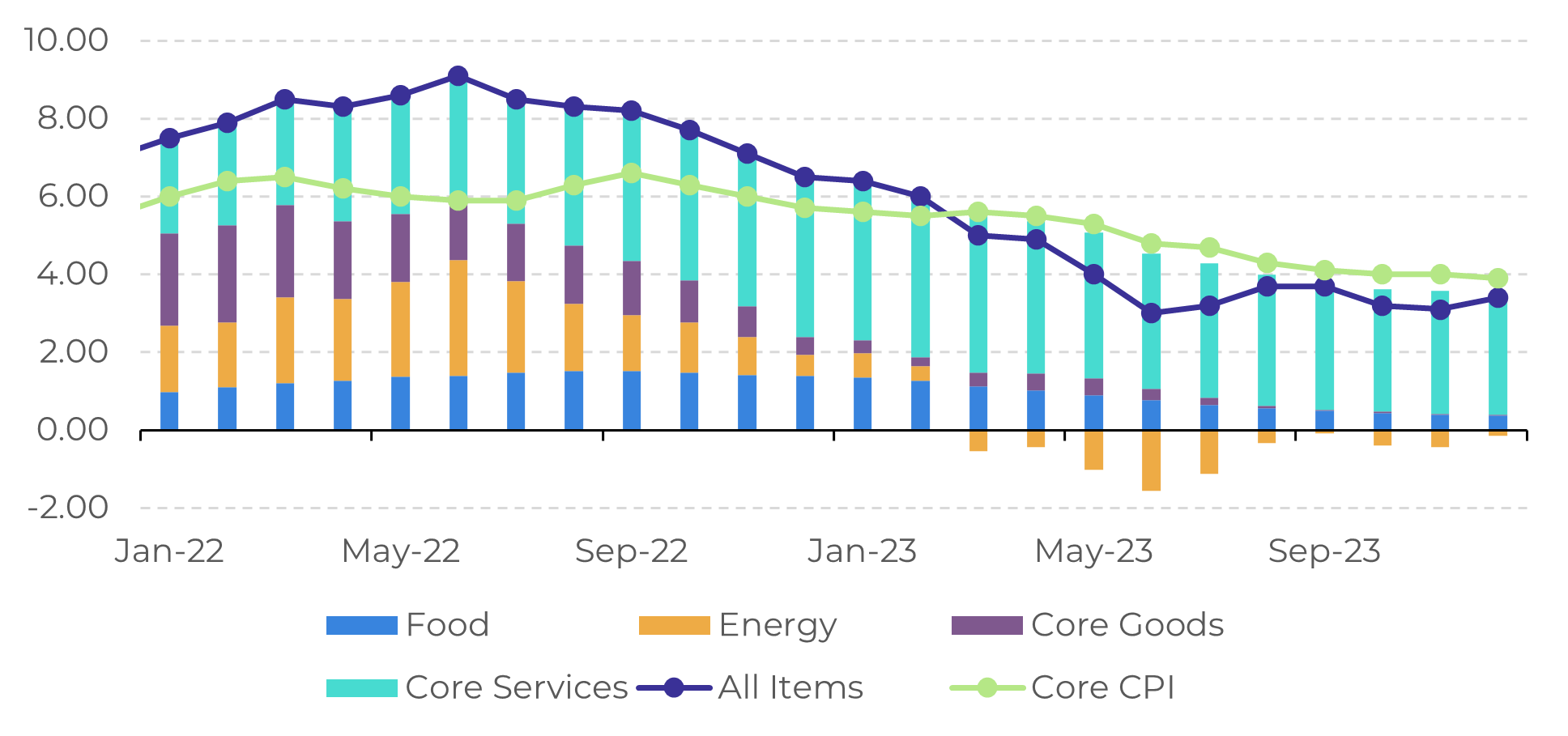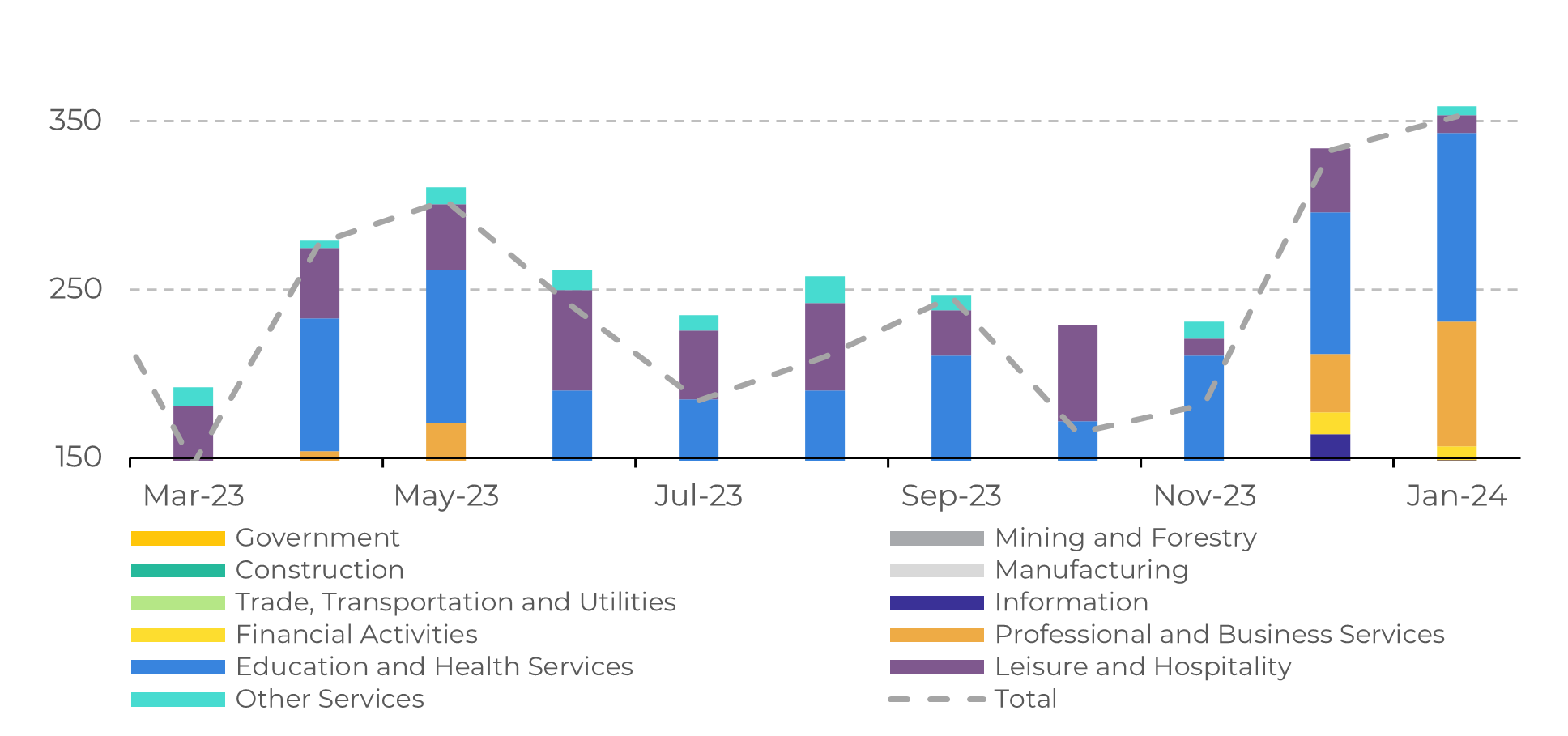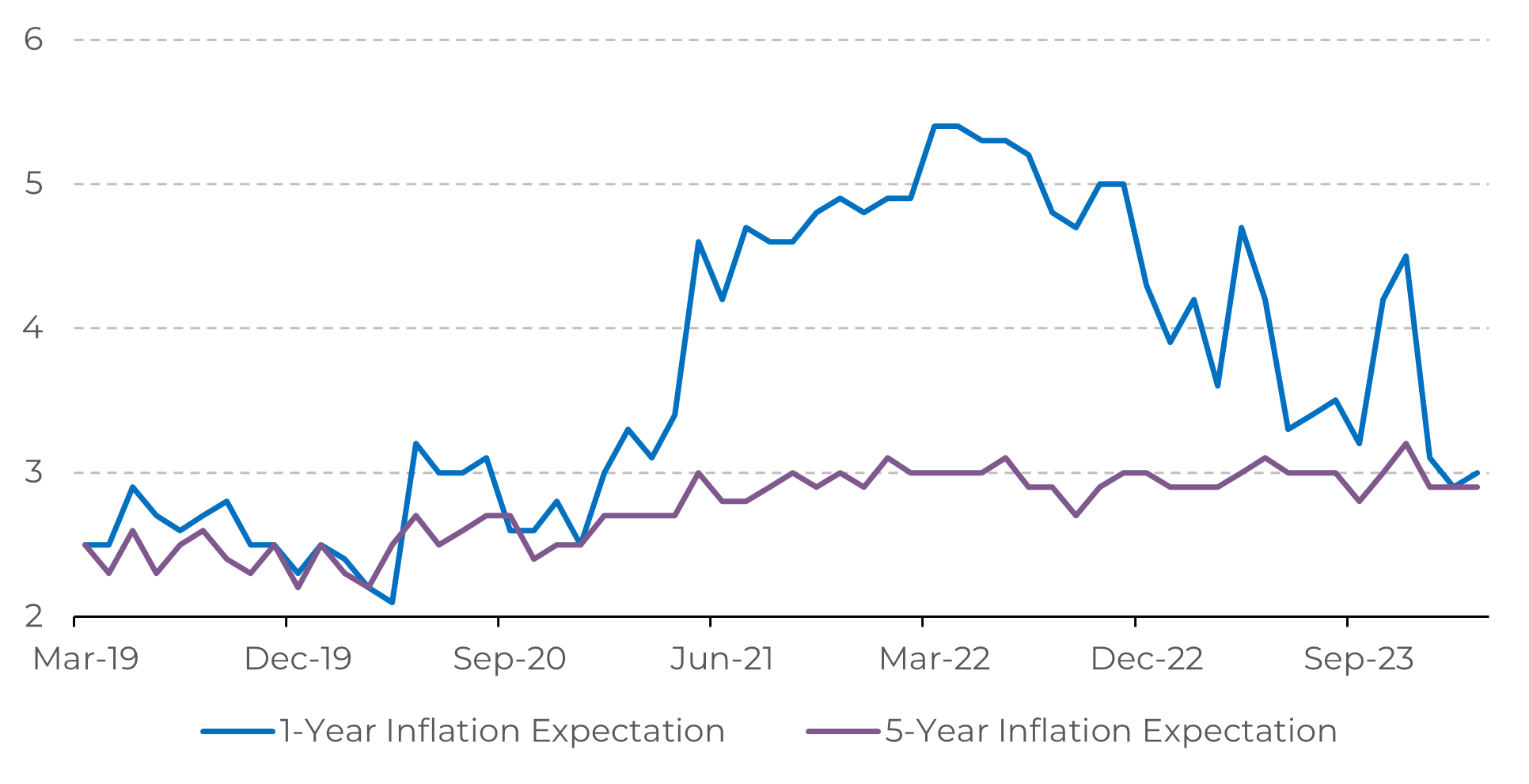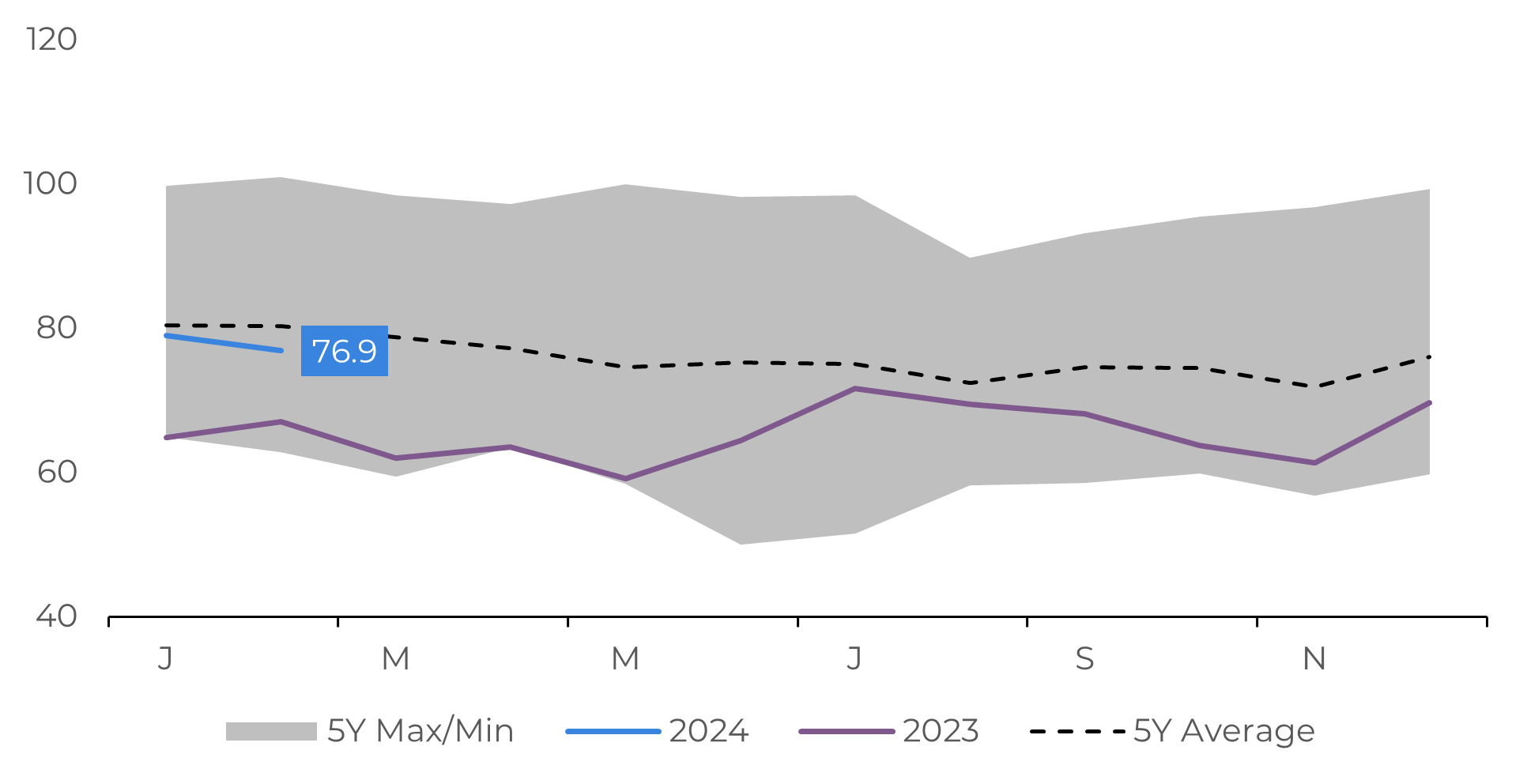
Mar 5
/
Victor Arduin
Macroeconomics Weekly Report - 2024 03 05
Back to main blog page
Inflation expectations show anchoring in the US
- Because of the upward surprise in inflation data in January, we have seen a more cautious Fed with the long-awaited interest rate cut.
- In the official announcement of the last meeting, a more hawkish tone was adopted. Despite increasing risk aversion, the speech was important for continuing to anchor inflation expectations.
- However, even in the face of a still uncertain scenario due to possible external shocks coming from Europe or the Middle East, the trend is for an interest rate cut to take place in June this year.
Introduction
One of the most significant events on the international macroeconomic scene in 2024 will undoubtedly be the interest rate cut in the United States. Despite inflation reaching its worst level in 30 years over the last two years, the rapid and firm response of restrictive monetary policy has managed, over the last 20 months, to slow inflation from a high of +9.1% (June/22) to +3.1% (January/24).
However, upward surprises in the labor market, such as the latest non-farm employment report which registered an increase of 353,000 jobs (+6.01%), and the persistence of inflation in some service sectors, such as transportation and medical care, led the Fed, at its last meeting, to adopt a more cautious stance with regard to easing borrowing costs in the country. Despite this, inflation expectations seem to be well anchored, painting a favorable scenario for inflation this year. This will be the focus of our analysis.
Image 1: US - CPI inflation (%)

Source: Bureau of Labor Statistics
Image 2: US - Increase in Non-Farm Payrolls (thousand jobs)

Source: Bureau
of Labor
Statistics
Where are US Treasuries going?
One of the reasons why the Fed, needs to be cautious about inflation and adopted a more hawkish discourse at its last meeting is to keep inflation expectations anchored, a risk less discussed in relation to employment data, but just as important. Currently, the median inflation expectation for the next 12 months stands at 3.1%, despite a slight worsening in the February data. We haven't seen optimistic inflation expectations at such a positive level since March 2021.
However, there are some risks that could bring volatility to the market, but without altering the natural trend of general prices converging towards the 2% target. Rental inflation remains high, a phenomenon that is difficult to explain, perhaps linked to the fact that high interest rates have driven buyers away from real estate financing and consequently heated up the rental market. Another risk, beyond the control of monetary policy, is the cost of transportation, which has increased due to logistical challenges in Panama (consequences of climatic effects) and the detour of ships from the Suez Canal (consequences of geopolitical effects).
Image 3: US - Inflation Expectations (Median)

Source: Refinitiv
Overall, the scenario seems quite favorable for an interest rate cut in June this year, especially if there is forward guidance to that extent at the next Fed meeting at the end of the month. Consumer confidence also strengthens the idea of anchored expectations. Even though the index fell two points in February compared to January, the gains made over the last 3 months are maintained and remain substantially higher than the historically low levels seen at the beginning of 2023.
Moreover, the Personal Consumption Expenditures (PCE), the inflation index most closely monitored by the Fed, dropped from over 5% in early 2023 to 2.4% in January 2024. This decline in prices has occurred without causing a recession in the country, a significant risk in the previous year but quite remote at this time, while also preserving the labor market without recording an increase in the unemployment rate.
Image 4: US - Consumer Sentiment Index

Source: Refinitiv
In Summary
The inflationary scenario in the United States still carries some risks for inflation that cannot be ignored, such as the strong expansion of economic activity in 2023 (+2.5%) and the resilient labor market.
In addition, inflation related to rents has taken longer to fall. Although it is widely discussed by the market and academics, it is not clear why this "delayed" effect of interest rates on this component has occurred.
So far, the cautious tone and hawkish speech were important in anchoring expectations and are part of the Fed's strategy to facilitate its process of reaching the 2% inflation target. A cut in the US interest rate is therefore expected by the end of the second quarter.
Weekly Report — Macro
Written by Victor Arduin
victor.arduin@hedgepointglobal.com
victor.arduin@hedgepointglobal.com
Reviewed by Alef Dias
alef.dias@hedgepointglobal.com
alef.dias@hedgepointglobal.com
www.hedgepointglobal.com
Disclaimer
This document has been prepared by hEDGEpoint Global Markets LLC and its affiliates ("HPGM") exclusively for informational and instructional purposes, without the purpose of creating obligations or commitments with third parties, and is not intended to promote an offer, or solicitation of an offer, to sell or buy any securities or investment products. HPGM and its associates expressly disclaim any use of the information contained herein that may result in direct or indirect damage of any kind. If you have any questions that are not resolved in the first instance of contact with the client (client.services@hedgepointglobal.com), please contact our internal ombudsman channel (ouvidoria@hedgepointglobal.com) or 0800-878-8408 (for clients in Brazil only).
Contact us
hedgepointhub.support@hedgepointglobal.com
ouvidoria@hedgepointglobal.com
Funchal Street, 418, 18º floor - Vila Olímpia São Paulo, SP, Brasil
This page has been prepared by Hedgepoint Schweiz AG and its affiliates (“Hedgepoint”) solely for informational and instructional purposes, without the purpose of instituting obligations or commitments to third parties, nor is it intended to promote an offer, or solicitation of an offer of sale or purchase relating to any securities, commodities interests or investment products. Hedgepoint and its associates expressly disclaim any use of the information contained herein that directly or indirectly result in damages or damages of any kind. Information is obtained from sources which we believe to be reliable, but we do not warrant or guarantee the timeliness or accuracy of this information. The trading of commodities interests such as futures, options, and swaps involves substantial risk of loss and may not be suitable for all investors. You should carefully consider wither such trading is suitable for you in light of your financial condition. Past performance is not necessarily indicative of future results. Customers should rely on their own independent judgement and/or advisors before entering in any transaction.Hedgepoint does not provide legal, tax or accounting advice and you are responsible for seeking any such advice separately.Hedgepoint Schweiz AG is organized, incorporated, and existing under the laws of Switzerland, is filiated to ARIF, the Association Romande des Intermédiaires Financiers, which is a FINMA-authorized Self-Regulatory Organization. Hedgepoint Commodities LLC is organized, incorporated, and existing under the laws of the USA, and is authorized and regulated by the Commodity Futures Trading Commission (CFTC) and a member of the National Futures Association (NFA) to act as an Introducing Broker and Commodity Trading Advisor. HedgePoint Global Markets Limited is Regulated by the Dubai Financial Services Authority. The content is directed at Professional Clients and not Retail Clients. Hedgepoint Global Markets PTE. Ltd is organized, incorporated, and existing under the laws of Singapore, exempted from obtaining a financial services license as per the Second Schedule of the Securities and Futures (Licensing and Conduct of Business) Act, by the Monetary Authority of Singapore (MAS). Hedgepoint Global Markets DTVM Ltda. is authorized and regulated in Brazil by the Central Bank of Brazil (BCB) and the Brazilian Securities Commission (CVM). Hedgepoint Serviços Ltda. is organized, incorporated, and existing under the laws of Brazil. Hedgepoint Global Markets S.A. is organized, incorporated, and existing under the laws of Uruguay. In case of questions not resolved by the first instance of customer contact (client.services@Hedgepointglobal.com), please contact internal ombudsman channel (ombudsman@hedgepointglobal.com – global or ouvidoria@hedgepointglobal.com – Brazil only) or call 0800-8788408 (Brazil only).Integrity, ethics, and transparency are values that guide our culture. To further strengthen our practices, Hedgepoint has a whistleblower channel for employees and third-parties by e-mail ethicline@hedgepointglobal.com or forms Ethic Line – Hedgepoint Global Markets.Security note: All contacts with customers and partners are conducted exclusively through our domain @hedgepointglobal.com. Do not accept any information, bills, statements or requests from different domains and pay special attention to any variations in letters or spelling, as they may indicate a fraudulent situation.“HedgePoint” and the “HedgePoint” logo are marks for the exclusive use of HedgePoint and/or its affiliates. Use or reproduction is prohibited, unless expressly authorized by HedgePoint. Furthermore, the use of any other marks in this document has been authorized for identification purposes only. It does not, therefore, imply any rights of HedgePoint in these marks or imply endorsement, association or seal by the owners of these marks with HedgePoint or its affiliates.

